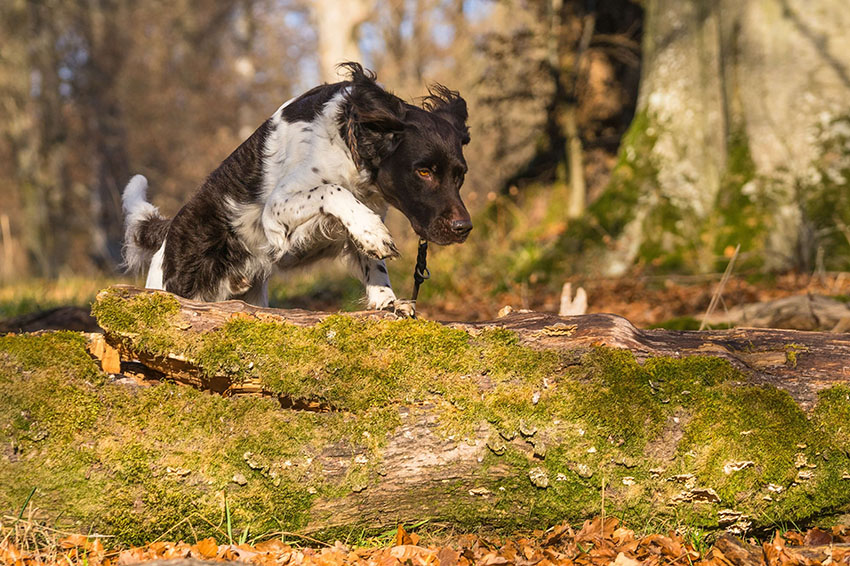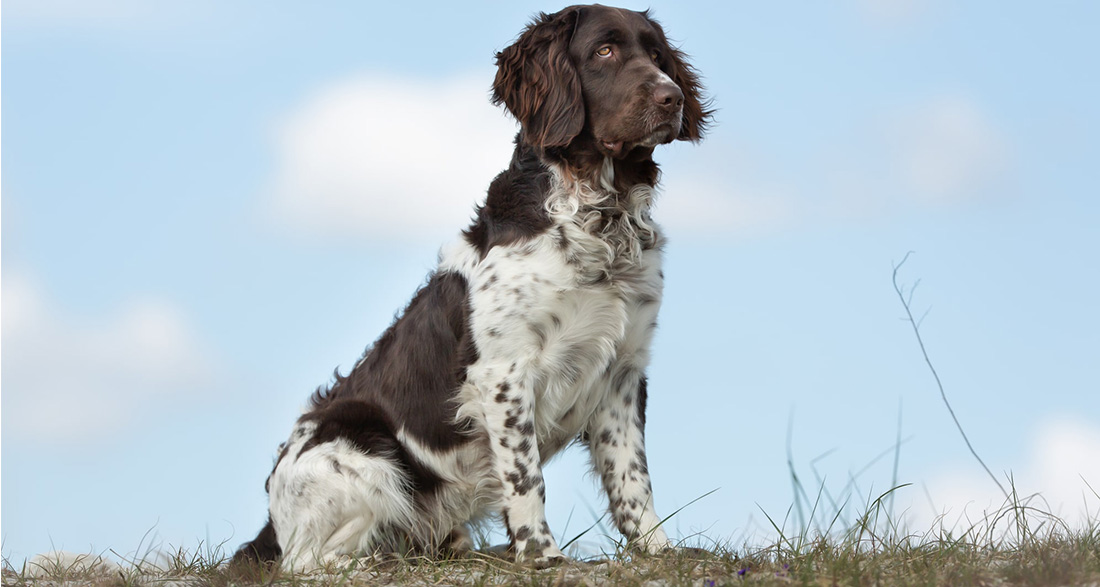The Small Munsterlander is a relatively unknown dog breed from Germany. These skilled hunting dogs are the smallest representatives of the German pointing dog breeds. Here in the profile, you’ll find everything about the history, care, and maintenance of this four-legged companion.
History of the Small Munsterlander
The Small Munsterlander originally descended from the long-haired quail dogs, which were very popular among hunters in the Münsterland region around 1870. Their task was to track down poultry and indicate it to the hunter. After the shot, they were also expected to retrieve it. The pure breeding of the Small Munsterlander began at the beginning of the 20th century.
The German forester Edmund Löns bred the breed between 1902 and 1907 from old bird dogs. He named these agile, small dogs “Heath Quail” because the heath was their main area of use. In parallel, another breed developed from the hunting dogs, known as the “Large Munsterlander.” To this day, the breed is primarily a versatile hunting dog, used in almost any terrain.
Today, these dogs are mainly found in France, Sweden, and Norway. However, due to its attractive appearance, the “Munsti” is becoming increasingly popular among German families. Internationally, the Small Munsterlander is classified in the FCI Group Pointing Dogs.
Breed Overview
GROUP: Working
HEIGHT: 20.5-21 inches
WEIGHT: 40-60 pounds
COAT: double medium coat
COAT COLOR: Black and white, Brown and white, Black, Brown
LIFE SPAN: 12 to 14 years
TEMPERAMENT: assertive, attentive, happy, intelligent
HYPOALLERGENIC: No
ORIGIN: Germany
Traits and Characteristics
The Small Munsterlander is an intelligent and friendly dog with a strong hunting instinct. With its spirited, open-hearted nature, the “Munsti” immediately wins everyone’s sympathy. It has a pronounced willingness to work and needs fulfilling tasks. Due to its playful and cheerful nature, the dog gets along easily with children.
If raised together, it can also get along with other pets and restrain its hunting instinct. With proper exercise, there is no reason why it cannot be kept in a family environment. Munstis are generally very obedient and eager to learn. Their strong temperament is especially evident during hunting. Nevertheless, they remain calm and loyal to their owner during the hunt.
| Affection Level | High |
| Friendliness | Medium |
| Kid-Friendly | High |
| Pet-Friendly | Medium |
| Exercise Needs | High |
| Playfulness | Medium |
| Energy Level | High |
| Trainability | High |
| Intelligence | High |
| Tendency to Bark | Low |
| Amount of Shedding | Medium |
Acquiring a Small Munsterlander
What should I consider when buying one?
Before getting a Small Munsterlander, you should be aware that it is a passionate hunting dog. You must be absolutely sure that you can meet the needs of this active dog. The Small Munsterlander is definitely not a dog for beginners and is only suitable for people willing to work intensively with them. Before buying, it’s best to contact the IGKlM Friends (International Community of Small Munsterlander Friends e.V.) and visit a few adult dogs to get to know them.
You can get your own dog either from a shelter or a breeder. When buying from a breeder, make sure they are affiliated with a AKC (American Kennel Club) or hunting dog association. You may have to spend a bit more than with untrustworthy offers from the internet, but you’ll be sure to get a purebred and healthy puppy. However, many breeders only give their puppies to trained hunters or foresters, where the dog will be properly challenged.

Puppy Training
The Small Munsterlander requires strong leadership from someone who can expertly and consistently train them. It’s best if you already have some experience with hunting dogs and understand their needs. Especially if you don’t intend to use the dog for hunting, you must work to mitigate its hunting instincts. You need to channel its high intelligence, sharp senses, and extraordinary willingness to perform into the right direction.
Training should be gentle and should not involve violence or pressure. To ensure the puppy gets along well with other dogs later on, socialization is crucial. The best way to achieve this is by attending puppy classes, where your Munsti can interact with and play with other dogs.
How to Care for a Small Munsterlander?
Activities with the Small Munsterlander:
The Small Munsterlander is an active hunting dog that finds its greatest joy in hunting. If you’re not acquiring it for hunting purposes, this demanding dog needs equally stimulating activities to keep it occupied. Daily walks and mental stimulation are an absolute must. Additionally, engaging your Munsti in a dog sport like agility or professional dummy training would be ideal.
You can also get the energetic dog interested in activities such as jogging, cycling, or hiking, allowing you to stay active too. Thanks to its love for water, it enjoys jumping into the lake and swimming, especially in summer. With the appropriate training, you can even use the Munsti as a search and rescue dog. However, this breed is less suited for guard duties as they tend to be very friendly towards strangers.

Health and Grooming
Despite its medium-length coat, caring for the Small Munsterlander is not very demanding. Regular brushing and cleaning off dirt after walks are usually sufficient. Its dense coat protects it from thorns, rain, or cold weather when outdoors. These dogs are not particularly prone to illness and can easily live to be 12 to 14 years old. They maintain their endurance and temperament throughout their lives. However, lack of exercise and boredom can lead to behavioral issues and potential health problems.
Interesting Facts
Small Munstis are versatile working dogs. In Germany, they are not only used in hunting but also in various other industries. One particularly unusual profession is held by the male dog Mäx from the Oberpfalz region. Together with his owner, he checks whether trees are infested with fungi. These tree pathogen detection dogs are a great help in a forester’s daily life.
Another fascinating profession is that of the dog Jim from Allershausen. The Small Munsterlander is trained to detect bedbugs in luxury hotels. During his work, he can check 15 rooms per day and is highly successful in his searches. To honor the breed, a large gathering is held in the Münsterland region once a year, where owners and enthusiasts can exchange experiences.
Do you also have a Small Munsterlander or are you considering getting one? Share with me in the comments what you think makes this breed so special!


